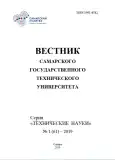Influence of the pulse-width modulation on the harmonic composition of the output voltage of a frequency converter
- Authors: Starikov A.V.1, Lisin S.L.1, Rokalo D.Y.1
-
Affiliations:
- Samara State Technical University
- Issue: Vol 27, No 1 (2019)
- Pages: 153-166
- Section: Electrical Engineering
- URL: https://journals.eco-vector.com/1991-8542/article/view/21319
- DOI: https://doi.org/10.14498/tech.2019.1.%25u
- ID: 21319
Cite item
Full Text
Abstract
Currently developed high-speed response digital AC drives, with exceptional ease of technical implementation, which is to minimize the computational procedures. They used frequency converters with trapezoidal output phase voltage, differing in structural simplicity compared with similar devices using the vector principle of voltage generation. At the same time, switching losses in power transistors of such converters are at least 25% less than in analogues with vector modulators. The purpose of the study is to determine the influence of the pulse-width modulation processes on the harmonic composition of the output phase voltage of the frequency converter. The digital modulator which forms a trapezoidal phase voltage by means of the frequency converter on the stator windings of an induction motor is considered. Its main constructive features that can influence on the harmonic composition of the output voltage are determined. To solve of the put problem the decomposition of a piecewise constant function of the output voltage of the frequency converter in the harmonic Fourier series is applied. Analytical expressions for determining of the amplitudes of the fundamental and higher harmonics in the output signal of the frequency converter that forms a trapezoidal phase voltage, taking into account the processes of pulse-width modulation are found. The obtained formulas made it possible to determine the dependences of the higher harmonic coefficients both in the function of the pulse-width modulation frequency and in the function of the frequency of the fundamental harmonic. It is shown that even harmonics and harmonics with the numbers multiple to three are absent in the output signal of the considered frequency converter. The curves of the dependences of the relative values of the odd harmonics coefficients from frequency of pulse-width modulation and frequency of the basic harmonic are constructed. It is concluded that even with allowance of the pulse-width modulation the frequency converter forming trapezoidal phase voltage has small amplitudes of higher harmonics and corresponds to the requirements of the State Standard. Nevertheless, quantitative estimates of the negative effect of the pulse-width modulation process on the output signal of the frequency converter are obtained.
About the authors
A. V. Starikov
Samara State Technical University
Author for correspondence.
Email: info@eco-vector.com
Russian Federation
S. L. Lisin
Samara State Technical University
Email: info@eco-vector.com
Russian Federation
D. Yu. Rokalo
Samara State Technical University
Email: info@eco-vector.com
Russian Federation
References
Supplementary files







